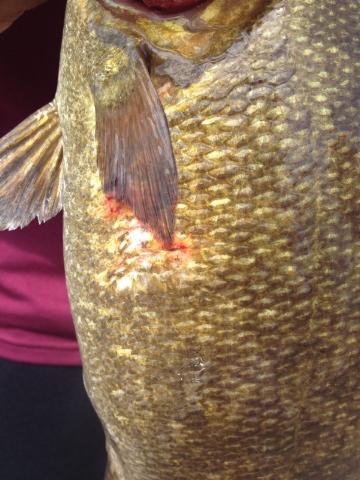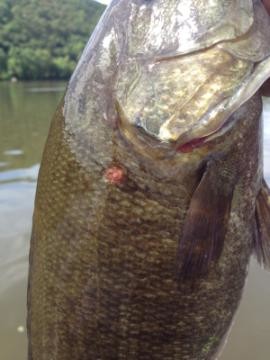
Maybe you’re early and its time for the early bird special. As you are sitting down, you start to look around and you see about a quarter of the people there have sores on their faces and arms, as if they have leprosy or some other nasty disease. you think, “what’s in the water, I better get out of here?”
Next, you go to the mall and you start to notice something strange. It’s Saturday night and all you see are people who look to be 45 years old and older. Where are all the kids? Shouldn’t they be out, hanging out and getting into trouble?
You think, what’s going on here? How will this town survive? It doesn’t take a rocket scientist to figure out that a population isn’t sustainable if there are no kids.
Where are all the baby bass?
That, my friends, is the state of the main stem of the Susquehanna River . At first glance, it looks great. Catching 15, 17, 18 and 20 inch smallies is insanely fun. 2 weeks ago, in fact we landed 90 smallies and a walleye in a dawn to dusk day of fishing. Who’s gonna complain about that?
Well the scary thing was that there were very few young bass and at least 25% of the bass we caught had ulcerated sores on them. Not dark pigment. These were open sores that were most likely from columnaris bacteria. This bacteria is known to infect fish with unhealthy immune systems and in stressed conditions. If you have an adult population with no surviving offspring, what happens in a few years? A complete collapse of the entire smallmouth bass population of the Susky.
Why?
There are many thoughts about what is happening and many people that are concerned and trying to figure this out. The Pennsylvania Department of Environmental Protection has decided that there is no problem despite the state Fish and Boat Commission begging for action.
The biggest threat seems to be endocrine disruptors in the water, affecting reproduction and the immune systems of smallmouth bass. The rivers feeding into the Chesapeake Bay are holding fish that have intersex reproductive tissue (ovarian and testicular tissue in the same organ). This makes many of the bass infertile. Endocrine disruptors are chemicals in the water that affect the reproductive systems of species of fish. Could these affect our health and well being as well?
Among the suspects in the biologists’ detective work is a slew of contaminants: 15 PCB-related compounds, 13 flame retardants, 14 organochlorine chemicals and nine other pesticides, plus triclosan, used in anti-bacterial soap.
Endocrine-disrupting chemicals seem to be having serious impact. In samples that were studied, female cell characteristics showed up in almost all the male fish, Smith said — far more than the naturally-occurring rate. Original article here
Now it appears that this problem is not only isolated to the Potomac and Susquehanna Rivers. As this recent article states, it is becoming a problem in the Delaware River and Ohio River basin as well.
According to the study, sites in the Susquehanna drainage had more of those effects, and with greater severity, than sites in the Ohio drainage. In general, the percentage of agricultural land use was highest throughout the Susquehanna drainage and the Schuylkill River, and lowest throughout the Ohio drainage. Source
What are we to do about this? The US Geologic Survey that showed this widening problem needs to be publicized. We can’t sit idly by as one of the greatest smallmouth bass fisheries dies due to pollution. Whether it is agricultural run off or chemicals from industry, the source must be identified and taken care of.
Rivers have an amazing ability to heal if given the chance. Let’s work together to give it a chance.
Please share this with smallmouth bass anglers and conservationists everywhere.



